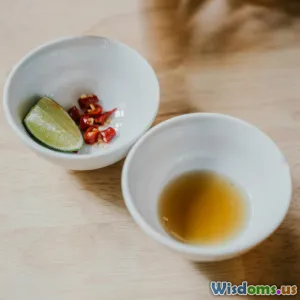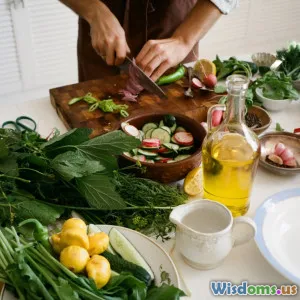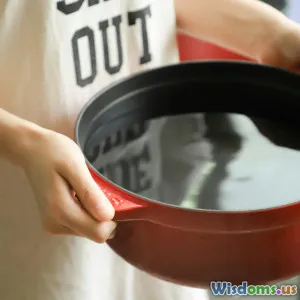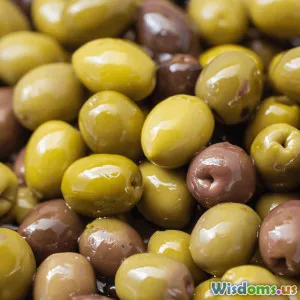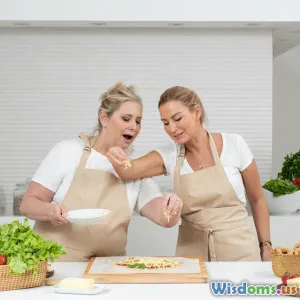
Secrets of World Class Chefs: Flavor Pairing Techniques
9 min read Unlock the secrets of world-class chefs with expert flavor pairing techniques that elevate every dish. (0 Reviews)
Secrets of World-Class Chefs: Flavor Pairing Techniques
Introduction
Imagine biting into a dish where every flavor dances perfectly in harmony, leaving your palate enchanted and craving more. What separates a good chef from a truly world-class one often comes down to mastering the art and science of flavor pairing. Flavor pairing is the deliberate matching of ingredients that complement or contrast each other to create heightened taste experiences. In this article, we dive deep into the secrets world-class chefs use to pair flavors brilliantly, revealing techniques backed by both science and tradition to inspire your culinary creativity.
Understanding the Foundation of Flavor Pairing
The Science Behind Taste
At its core, flavor pairing relies heavily on chemistry. Flavors are made up of volatile organic compounds that stimulate our taste buds and olfactory receptors. Studies, including those by food scientists like Heston Blumenthal and Hervé This, have shown that foods sharing similar molecular components often pair well together. For example, white chocolate and caviar share similar flavor compounds, creating a surprisingly harmonious match, despite one being sweet and the other salty.
The flavor wheel categorizes tastes into fundamental groups: sweet, sour, salty, bitter, and umami. Expert chefs manipulate these tastes by balancing acidity, bitterness, and saltiness to create layers of flavor.
Cultural and Emotional Contexts
Flavor isn’t just biology; it’s culture and memory. World-class chefs recognize traditional pairings linked to cultural preferences while using these as springboards for new combinations. For instance, the Italian classic pairing of tomato and basil thrives on regional tastes, but chefs worldwide have innovated by combining these ingredients with unexpected partners.
Techniques World-Class Chefs Use for Flavor Pairing
1. Pairing by Shared Aroma Compounds
This technique involves combining foods that contain common aromatic molecules. For example, the published "food pairing hypothesis" suggests that ingredients containing overlapping flavor molecules tend to blend well. A famous instance of this can be seen in a combination like blue cheese and dark chocolate, which both contain specific sulfur-based compounds.
One celebrated example is chef Ferran Adrià's use of scientific flavor pairing at El Bulli, where he matched white truffles with popcorn because of their shared 2-acetyl-1-pyrroline compound responsible for their toasted aromas.
2. Contrast and Counterbalance
Perfect harmony in cooking often includes deliberate balance through contrast. Bright acidity can cut through rich fats, while a touch of bitterness might tone down sweetness. Consider a classic French dish such as duck à l’orange, where the fatty duck meat is expertly contrasted by the bright, citrusy orange sauce.
World-class chefs frequently employ this technique — for example, adding a sprinkle of crunchy, slightly bitter radicchio to creamy risottos provides a layered mouthfeel and flavor depth.
3. Regional and Seasonal Pairing
Seasonality is a secret weapon in flavor pairings. Ingredients harvested at their peak offer more complex and balanced flavors, making pairing more intuitive. Pastry chefs, for instance, pair desserts like berry tarts with fresh mint in summer, while fall dishes focus on spices like cinnamon complemented by roasted nuts.
Further, chefs lean into regional pairings because the ingredients have evolved to complement each other naturally. Italian cuisine's marriage of tomato, olive oil, and garlic is a prime example, highlighting how environment influences flavor synergy.
4. Umami Amplification
Umami—the savory "fifth taste"—is key in crafting rich, satisfying dishes. Chefs harness umami-rich ingredients such as mushrooms, aged cheeses, cured meats, soy sauce, and tomatoes to enhance other components. Pairing umami with saltiness and sweetness can unpack new flavor dimensions.
Massimo Bottura, the acclaimed Italian chef, often experiments with umami layering—for example, combining Parmesan cheese with tomato water to create refined, savory notes that bring vibrancy to his dishes.
5. Texture and Temperature as Flavor Enhancers
While flavor compounds take center stage, world-class chefs also use contrasting textures and temperatures to accentuate flavor perception. A chilled cucumber salad with a hot spiced broth provides a sensory contrast that enriches the overall eating experience.
Jacques Pépin famously noted, “Texture is flavor’s understudy.” This highlights how crunchy, creamy, or juicy elements can emphasize or soften flavors, amplifying the complexity of a dish.
Real-World Application: Examples from Renowned Kitchens
Grant Achatz and Molecular Gastronomy
Chef Grant Achatz of Alinea uses both scientific data and creative experimentation to push flavor pairing boundaries. One innovative dish pairs foie gras with passion fruit and kaffir lime, mixing fatty richness with tropical sourness and herbaceous citrus. The combination exploits overlapping aroma compounds and textural contrasts to surprise diners.
René Redzepi’s Nordic Philosophy
At Noma, Redzepi champions foraged ingredients, using wild herbs, fermented foods, and unexpected pairings like sour wood sorrel with sweetbreads. His experiments delve into the natural environment, elevating humble ingredients by pairing them through shared terroir rather than conventional wisdom.
The Rise of Cross-Cultural Pairings
Culinary fusion brings new dimensions to traditional techniques. A chef may pair miso paste (umami-rich Japanese ingredient) with Mexican chili for a complex sweet-spicy umami profile. This approach reflects how world-class chefs embrace diversity in ingredient origin, applying fundamental flavor principles across cultures.
Tips for Home Cooks to Master Flavor Pairing
- Start with Similar Flavor Profiles: Combine ingredients with overlapping tastes or aromas like garlic and onion, or lemon and ginger.
- Balance Acidity and Fat: Use acids like vinegar or citrus to cut through fatty foods, as in pairing fresh salsa with grilled meats.
- Incorporate Umami Boosters: Mushrooms, soy sauce, and aged cheeses can add savory depth to soups, sauces, or roasted veggies.
- Experiment Mindfully: Take notes of successful combinations and learn from flavor mismatches.
- Explore Texture: Add crunch (nuts, seeds) to soft dishes for enhanced sensory interest.
Conclusion
Flavor pairing remains one of the most vital and mysterious arts in cooking—both a science and a craft. World-class chefs combine chemistry, culture, intuition, and creativity to surprise and delight diners globally. By understanding the principles of shared aroma compounds, balance through contrast, seasonality, and umami layering, home cooks and professionals alike can elevate dishes from ordinary to extraordinary. The true secret is a curious palate willing to explore and embrace unexpected partnerships that celebrate the harmony and complexity of flavor.
Unlock these techniques to not just cook, but compose culinary symphonies that captivate every sense.
"Good cooking is not just about ingredients, recipes, or cooking. It's about harnessing flavors to tell a story." – Massimo Bottura
References
- Blumenthal, Heston, and François Chartier. "The Science of Flavor." (Various publications and lectures)
- This, Hervé. Molecular Gastronomy: Exploring the Science of Flavor.
- Ferrari, Francois. "Food Pairing and Molecular Compatibility," International Journal of Gastronomy and Food Science, 2018.
Rate the Post
User Reviews
Popular Posts
















